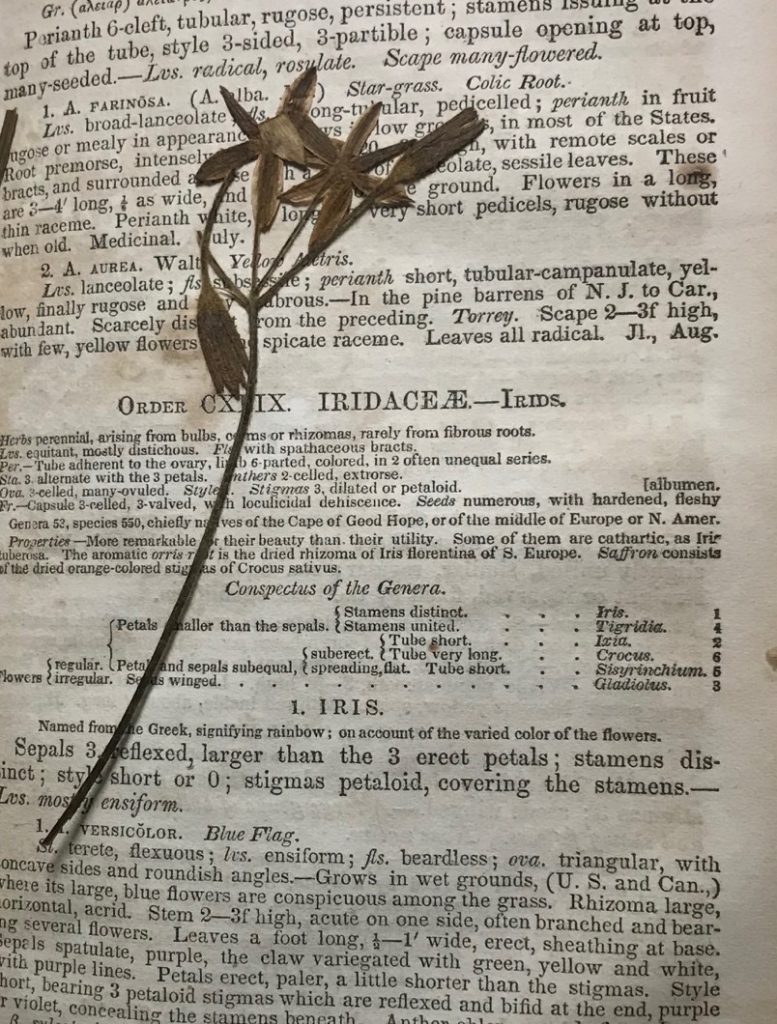Dr. Annie Merrill is currently writing a book on popular botany in the 19th-century United States.
In my research, I’ve studied hundreds of nineteenth-century American flower books, from tiny flower language dictionaries to lavishly illustrated folios of US flora. Their contents have much to tell us about scientific education, natural history, and botanical popular culture at that time. An individual book’s unique features such as inscriptions and marginalia also convey fascinating stories.

Hezekiah Wilson Marbourg was born in 1833 in Indiana county, Pennsylvania. He attended Pennsylvania College (now Gettysburg) and received an M.D. from Jefferson Medical College in 1858 (Pennsylvania College 361). During the Civil War, he was stationed on Roanoke Island as a surgeon for the U.S. Army (Portrait and Biographical Record 150). As the copious marginalia and pressed specimens in his copy of Wood’s Class-Book indicate, he was also one of the many amateur botanists in the 19thcentury US.

His marginalia all appear in the Flora section – a precursor to today’s field guides – and note a date and location, occasionally with a brief comment like “beautiful” or “pretty.” The earliest one is dated April 25, 1857: as a medical student, he likely “botanized” for recreation, recording the plants he encountered. He didn’t go far afield to find them; locations from 1857-58 include Logan Square and Franklin Square in Philadelphia and the Cement Quarry in Johnstown, PA.
Marbourg returned to Johnstown after the war and remarried in 1872, to Esther Nippes, also an M.D. They established a joint medical practice, and in the 1870s and 1880s Marbourg still noted a few plants in his Class-Book. The last marginalium appears next to the entry on the Smiling Wake-Robin (Trillium erythrocarpum), which he found on May 2, 1888 at the Cambria Furnaces, part of Johnstown’s largest steel and iron works. Marbourg died a year later in the Great Johnstown Flood of May, 1889 (Biographical and Portrait Cyclopedia 142).
A wide range of people were amateur botanists in the nineteenth century, and most of them “never wrote anything, or made a cent from botany, or joined an institution, or subscribed to a botanically inclined periodical” (Keeney 11). But at least one of them took the time to record his findings in his book, and that book still speaks to us today.

References:
Biographical and Portrait Cyclopedia of Cambria County, Pennsylvania. Philadelphia: Union Publishing, 1896.
Keeney, Elizabeth. The Botanizers: Amateur Scientists in Nineteenth-Century America. Chapel Hill: University of North Carolina Press, 1992.
Pennsylvania College Alumni Association. General Report Made to the Alumni Association of Pennsylvania College. Gettysburg: H. C. Neinstedt, 1860.
Portrait and Biographical Record of the State of Colorado. Chicago: Chapman, 1899.
Wood, Alphonso. Class-Book of Botany. Boston: Crocker & Brewster, 1855.

Speak Your Mind